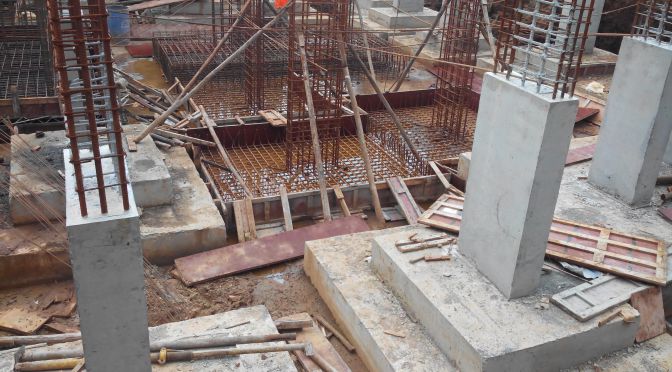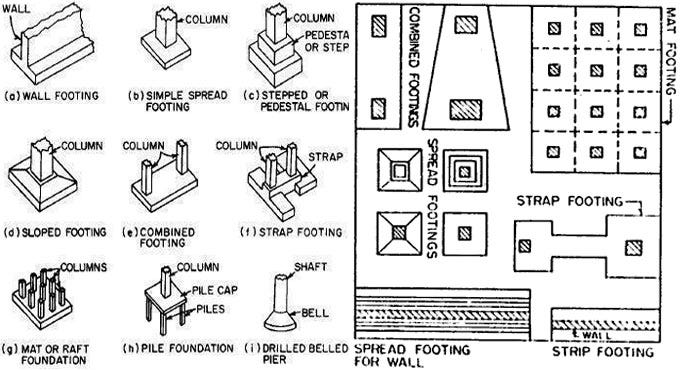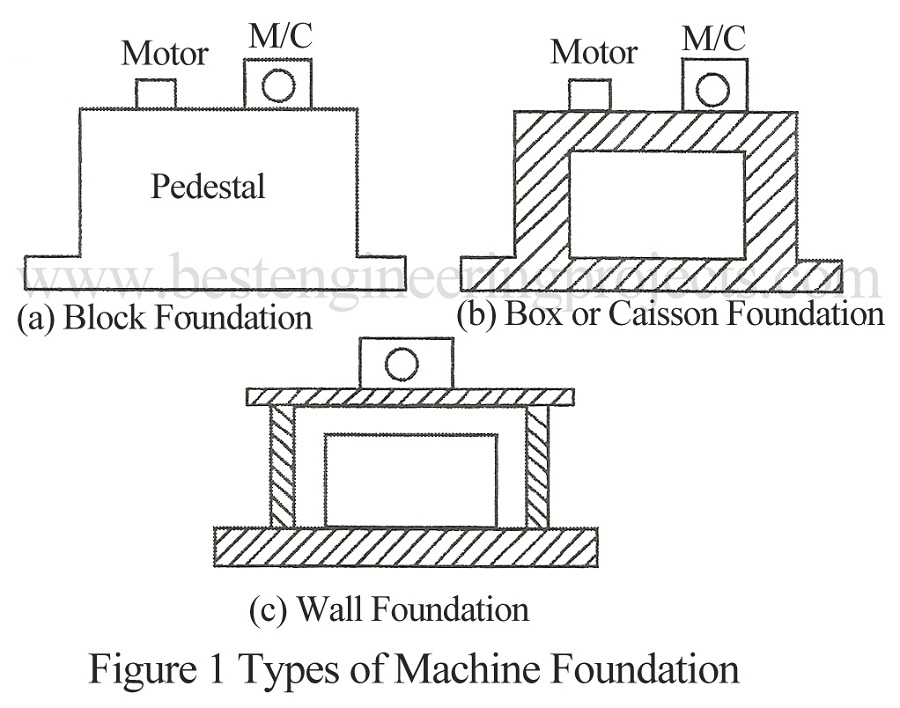Types of footing foundation pdf
CHAPTER 6 – FOUNDATION DESIGN 600. DESIGN PROCEDURE. In this chapter information about the building site and the building structure are combined and used to determine the size of footings, reinforcing for the foundation, and the size and spacing of an-chorage used to tie the unit to the foundation. 600-1. GENERAL A. Foundation Appendices. The foun-dation design information in …
FOUNDATION TYPES Residential foundation systems can be divided into six general categories: • No foundation • Partial foundation • Post and pier throughout • Perimeter footing with interior posts • Continuous perimeter and interior footings • Continuous footings with a slab floor on grade. With no foundation, or too small a partial foundation, the horizontal forces in the building
different foundation types; a brief description follows. A crawl space is a building foundation that uses a perimeter foundation wall to create an under-floor space that is not habitable; the interior crawl space elevation may or may not be below the exterior finish grade. A basement is typically defined as a portion of a building that is partly or completely below the exterior grade and that
There are various types of foundation. They can be categorized into two types. Types of Foundation. Foundations are mainly two types. Shallow Foundation, and; Deep Foundation. 1. Shallow Foundation . A shallow foundation is a type of foundation that transfers loads to the very near the surface. Shallow foundations typically have a depth to width ratio of less than 1. The shallow foundation
TYPES OF FOOTINGS. Footings are critical to the structural stability of a cottage. Footings are designed based on site topography, soil type, stability, and …
It is also called open foundation. Following are the type of footing: Isolated footing: Separate footing is provided under the column. It can be square, rectangular or circular in shape in plan. It can also be of uniform depth, sloped or stepped. Strip footing: This type of footing is provided under load bearing masonry walls in the form of strip. Combined footing: This type of footing is
StRIP FootInGS oVeRVIeW Common types of residential footing systems are outlined including blob, strip and pier and beam. Reinforcement for these footings, including trench mesh and bars, is also dealt with. Refer to Australian Standard AS2870. Excavation methods, manual and mechanical, are explained with a step-by-step procedure outlined, to manually excavate trenches. Also, methods of
Chapter 3, Foundations and Foundation Walls 53 3.2 CONCRETE FOUNDATIONS Regardless of Seismic Design Category, the minimum specified concrete strength for foundations (and foundation walls) is 2,500 pounds per square inch (psi) with higher strength necessary when a foundation is exposed to the weather and the house is located in a moderate or severe weathering probability area …
TYPES OF FOOTING Deep Foundation Precast Concrete

Types of Piers williamsonfoundation.com
CHAPTER 1. INTRODUCTION TO FOUNDATIONS The soil beneath structures responsible for carrying the loads is the FOUNDATION. The general misconception is that the structural element which transmits the load to the soil (such as a footing) is the foundation.
FOOTINGS, FOUNDATION WALLS, BASEMENTS, AND SLABS 191 may require a concrete footing that is wider than the wall itself and capable of distributing the weight of the structure over a larger area.
Footing and Its Types 1. Group 7 Group Members Umar Khatab 2013-BT–CIVIL-36 Abid Javaid 2013-BT–CIVIL-09 2. Footing The lowest load-bearing part of a building, typically below ground level is called footing Types of Footing There are three main types of foundation • Strip footing • Raft/Mat footing …
Bottom Left : Foundations in Marble Bottom Right : Construction of Large-diameter Bored Piles on Slope . This publication is a reference document that 3 . FOREWORD presents a review of the principles and practice related to design and construction of foundation, with specific reference to ground conditions in Hong Kong. The information given in the publication should facilitate the use of
ffi may be of various types according to their function: isolated footing, combined footing, strip footing, or mat foundation [1-4]. The structural design of foundations, by itself, represents the …
TYPES OF FOOTING. 1. Wall footing An enlargement of a bottom of a wall that will sufficiently distribute the load to the foundation soil. 2.
5 Spread footing process…3 • With the forms stripped, the foundation walls made of block or concrete can be constructed on the footing • If concrete block
The Drilled Concrete Pier is created by digging a starter hole, called a footing. This is common to all types of piers. From there, an auger is used to drill out a hole in the ground as deep as possible. The dirt is removed from the hole, thus leaving an empty shaft extending into the ground. Some drilled pier designs use 1 shaft while others use 2 shafts in each pier. These pier shafts can

A mat foundation is used when the subsoil is weak and column loads are so heavy that the conventional spread footings cover more than 50 % of the building area.
1 Chapter 5 Footing Design By S. Ali Mirza1 and William Brant2 5.1 Introduction Reinforced concrete foundations, or footings, transmit loads from a structure to the supporting soil.
vations, footings and foundations shall conform to the require- ments specified in Chapters 16, 19, 21, 22 and 23 of this code. Excavations and fills shall also comply with Chapter 33.

The distribution of soil pressure under a footing is a function of the type of soil, the relative rigidity of the soil and the footing, and the depth of foundation at level of contact between footing and soil.
Mat foundation – when a common foundation is provided for columns in two or more rows, the footing is called a mat or raft foundation. In case of low bearing capacity of the soil and when the foundation requires quite large area for load distribution, mat foundation is provided.
Bridge Foundations Section 6.1 January, 2018 2 Common Foundation Types • Spread Footing • Piling • Drilled Shafts Type Of Excavation “Dry” Excavation:
152031 FOOTING ADVICE REV B.DOCX 3 FOOTING TYPES A footing is the structural element that transfers the building’s load to the ground; the foundation is the ground
Foundations: Types and Considerations Dr. Adnan A. Basma 1 of 6 CHAPTER 1 INTRODUCTION TO FOUNDATIONS The soil beneath structures responsible for carrying the loads is the FOUNDATION. The general misconception is that the structural element which transmits the load to the soil (such as a footing) is the foundation. The figure below clarifies this point. TYPES OF FOUNDATIONS Foundations …
PART ONEI FOOTINGS AND FOUNDATIONS We’re going to talk about footings and foundations from a performance stand-point. We’re looking to see whether they’re doing their job.
Foundation Maintenance and Footing Performance: A Homeowner’s Guide Buildings can and often do move. This movement can be up, down, lateral or rotational. The fundamental cause of movement in buildings can usually be related to one or more problems in the foundation soil. It is important for the homeowner to identify the soil type in order to ascertain the measures that should be put in
The types of soils usually present under the topsoil in land zoned for residential buildings can be split into two approximate groups – granular and clay. Quite often, foundation soil is a mixture of both types. The general problems associated with soils having granular content are usually caused by erosion. Clay soils are subject to saturation and swell/shrink problems. Classifications for
Deep foundation is required to carry loads from a structure through weak compressible soils or fills on to stronger and less compressible soils or rocks at depth, or for functional reasons. Deep foundations are founded too deeply below the finished ground surface for their base bearing capacity to
Image by Jon Hurd . Many homeowners forget to consider house foundation types when planning for the construction of their new home. Although hardly visible if at all, foundations …
4 Basic Foundation Types for Your New Home — Superdraft
This type footing is commonly used for the foundations of load bearing walls or supports a slab. When it is necessary to stiffen the strip to resist differential settlements then tee or inverted tee strip footings …
A footing is placed below the frost line and then the walls are added on top. The footing is wider than the wall, providing extra support at the base of the foundation. A T-shaped foundation is placed and allowed to cure; second, the walls are constructed; and finally, the slab is poured between the walls.
3 Cairo University Requirements for Foundations Foundations should be placed below the top organic soil, fill materials, old abandoned foundations, & debris.
Poured Concrete Foundations. A poured concrete foundation is the most common type of home foundation, according to BobVila.com. A concrete slab foundation is formed by pouring a …
Different types of shallow and deep foundations are illustrated in that lesson. The design considerations and different codal provisions of foundation structures are also explained. However, designs of all types of foundations are beyond the scope of this course. Only shallow footings are taken up for the design in this lesson. Several numerical problems are illustrated applying the
Deck Footings. Learn everything you need to know about installing concrete footings to support your deck. We will teach you how to determine the code compliant size of your footings based on the soil type and tributary loads.
Some common types of foundations include: Strip foundation – this is a continuous piece or strip of concrete that goes underneath walls. Raft foundation – a foundation that gives a solid continuous base underneath the entirety of the building.
3 i) All loads that may act on foundations should be studied and determined. ii) Site investigation should be carried out. iii) Depth of foundation must be determined. – linux foundation certified engineer pdf
What is strip footing? Quora
Footings Foundation Walls Basements and Slabs

06 Bridge Foundations 11 7 17 oregon.gov
Decks.com. Deck footings foundations and piers



–


What is strip footing? Quora
Module 11 nptel.ac.in
A footing is placed below the frost line and then the walls are added on top. The footing is wider than the wall, providing extra support at the base of the foundation. A T-shaped foundation is placed and allowed to cure; second, the walls are constructed; and finally, the slab is poured between the walls.
Deep foundation is required to carry loads from a structure through weak compressible soils or fills on to stronger and less compressible soils or rocks at depth, or for functional reasons. Deep foundations are founded too deeply below the finished ground surface for their base bearing capacity to
Mat foundation – when a common foundation is provided for columns in two or more rows, the footing is called a mat or raft foundation. In case of low bearing capacity of the soil and when the foundation requires quite large area for load distribution, mat foundation is provided.
vations, footings and foundations shall conform to the require- ments specified in Chapters 16, 19, 21, 22 and 23 of this code. Excavations and fills shall also comply with Chapter 33.
Image by Jon Hurd . Many homeowners forget to consider house foundation types when planning for the construction of their new home. Although hardly visible if at all, foundations …
FOOTINGS, FOUNDATION WALLS, BASEMENTS, AND SLABS 191 may require a concrete footing that is wider than the wall itself and capable of distributing the weight of the structure over a larger area.
Footings Foundation Walls Basements and Slabs
Chapter 5 Footing Design Engineering
What is strip footing? Quora
A mat foundation is used when the subsoil is weak and column loads are so heavy that the conventional spread footings cover more than 50 % of the building area.
4 Basic Foundation Types for Your New Home — Superdraft
TYPES OF FOOTING Deep Foundation Precast Concrete
Deep foundation is required to carry loads from a structure through weak compressible soils or fills on to stronger and less compressible soils or rocks at depth, or for functional reasons. Deep foundations are founded too deeply below the finished ground surface for their base bearing capacity to
What is strip footing? Quora
Module 11 nptel.ac.in
Deep foundation is required to carry loads from a structure through weak compressible soils or fills on to stronger and less compressible soils or rocks at depth, or for functional reasons. Deep foundations are founded too deeply below the finished ground surface for their base bearing capacity to
What is strip footing? Quora
Chapter 5 Footing Design Engineering
Foundations and footings Introduction OTEN – Your Decision
ffi may be of various types according to their function: isolated footing, combined footing, strip footing, or mat foundation [1-4]. The structural design of foundations, by itself, represents the …
TYPES OF FOOTING Deep Foundation Precast Concrete
Decks.com. Deck footings foundations and piers
Mat foundation – when a common foundation is provided for columns in two or more rows, the footing is called a mat or raft foundation. In case of low bearing capacity of the soil and when the foundation requires quite large area for load distribution, mat foundation is provided.
06 Bridge Foundations 11 7 17 oregon.gov
PART ONEI FOOTINGS AND FOUNDATIONS We’re going to talk about footings and foundations from a performance stand-point. We’re looking to see whether they’re doing their job.
4 Basic Foundation Types for Your New Home — Superdraft
What is strip footing? Quora
Types of Piers williamsonfoundation.com
5 Spread footing process…3 • With the forms stripped, the foundation walls made of block or concrete can be constructed on the footing • If concrete block
Chapter 5 Footing Design Engineering
The Drilled Concrete Pier is created by digging a starter hole, called a footing. This is common to all types of piers. From there, an auger is used to drill out a hole in the ground as deep as possible. The dirt is removed from the hole, thus leaving an empty shaft extending into the ground. Some drilled pier designs use 1 shaft while others use 2 shafts in each pier. These pier shafts can
CHAPTER 6 FOUNDATION DESIGN
Module 11 nptel.ac.in
Chapter 5 Footing Design Engineering
CHAPTER 1. INTRODUCTION TO FOUNDATIONS The soil beneath structures responsible for carrying the loads is the FOUNDATION. The general misconception is that the structural element which transmits the load to the soil (such as a footing) is the foundation.
06 Bridge Foundations 11 7 17 oregon.gov
5 FOUNDATIONS Association of Bay Area Governments
3 i) All loads that may act on foundations should be studied and determined. ii) Site investigation should be carried out. iii) Depth of foundation must be determined.
Module 11 nptel.ac.in
The distribution of soil pressure under a footing is a function of the type of soil, the relative rigidity of the soil and the footing, and the depth of foundation at level of contact between footing and soil.
CHAPTER 6 FOUNDATION DESIGN
Chapter 5 Footing Design Engineering
152031 FOOTING ADVICE REV B.DOCX 3 FOOTING TYPES A footing is the structural element that transfers the building’s load to the ground; the foundation is the ground
5 FOUNDATIONS Association of Bay Area Governments
CHAPTER 1. INTRODUCTION TO FOUNDATIONS The soil beneath structures responsible for carrying the loads is the FOUNDATION. The general misconception is that the structural element which transmits the load to the soil (such as a footing) is the foundation.
What is strip footing? Quora
06 Bridge Foundations 11 7 17 oregon.gov
Some common types of foundations include: Strip foundation – this is a continuous piece or strip of concrete that goes underneath walls. Raft foundation – a foundation that gives a solid continuous base underneath the entirety of the building.
TYPES OF FOOTING Deep Foundation Precast Concrete
CHAPTER 6 FOUNDATION DESIGN
Types of Piers williamsonfoundation.com
different foundation types; a brief description follows. A crawl space is a building foundation that uses a perimeter foundation wall to create an under-floor space that is not habitable; the interior crawl space elevation may or may not be below the exterior finish grade. A basement is typically defined as a portion of a building that is partly or completely below the exterior grade and that
4 Basic Foundation Types for Your New Home — Superdraft
CHAPTER 6 FOUNDATION DESIGN